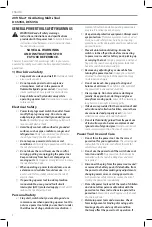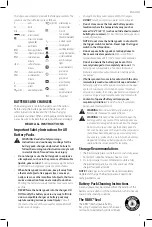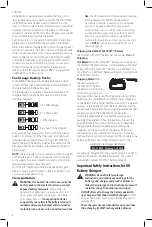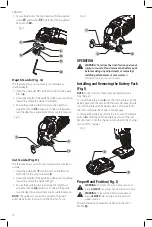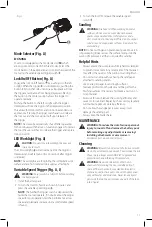
3
English
damaged, have the power tool repaired before
use.
Many accidents are caused by poorly maintained
power tools.
f )
Keep cutting tools sharp and clean.
Properly
maintained cutting tools with sharp cutting edges are
less likely to bind and are easier to control.
g )
Use the power tool, accessories and tool bits etc.
in accordance with these instructions, taking
into account the working conditions and the
work to be performed.
Use of the power tool for
operations different from those intended could result
in a hazardous situation.
h )
Keep handles and grasping surfaces dry, clean
and free from oil and grease.
Slippery handles and
grasping surfaces do not allow for safe handling and
control of the tool in unexpected situations.
1) Battery Tool Use and Care
a )
Recharge only with the charger specified by the
manufacturer.
A charger that is suitable for one type
of battery pack may create a risk of fire when used
with another battery pack.
b )
Use power tools only with specifically designated
battery packs.
Use of any other battery packs may
create a risk of injury and fire.
c )
When battery pack is not in use, keep it away
from other metal objects, like paper clips, coins,
keys, nails, screws or other small metal objects,
that can make a connection from one terminal to
another.
Shorting the battery terminals together may
cause burns or a fire.
d )
Under abusive conditions, liquid may be ejected
from the battery; avoid contact. If contact
accidentally occurs, flush with water. If liquid
contacts eyes, additionally seek medical help.
Liquid ejected from the battery may cause irritation
or burns.
e )
Do not use a battery pack or tool that is
damaged or modified.
Damaged or modified
batteries may exhibit unpredictable behavior resulting
in fire, explosion or risk of injury.
f )
Do not expose a battery pack or tool to
fire or excessive temperature.
Exposure to
fire or temperature above 265 °F (130 °C) may
cause explosion.
g )
Follow all charging instructions and do not
charge the battery pack or tool outside the
temperature range specified in the instructions.
Charging improperly or at temperatures outside the
specified range may damage the battery and increase
the risk of fire.
Service
a )
Have your power tool serviced by a qualified
repair person using only identical replacement
parts.
This will ensure that the safety of the power
tool is maintained.
b )
Never service damaged battery packs.
Service
of battery packs should only be performed by the
manufacturer or authorized service providers.
Additional Safety Rules for Oscillating
Multi-Tools
•
Hold power tool by insulated gripping surfaces,
when performing an operation where the cutting
accessory may contact hidden wiring.
Cutting
accessory contacting a “live” wire may make exposed
metal parts of the power tool “live” and could give the
operator an electric shock.
•
Use clamps or another practical way to secure and
support the work piece to a stable platform.
Holding
the work by hand or against your body leaves it unstable
and may lead to loss of control.
•
Air vents often cover moving parts and should be
avoided.
Loose clothes, jewelry or long hair can be
caught in moving parts.
•
Disconnect power before using tool near live wires or
where there may be hidden wiring.
Cutting accessory
contacting a “live” wire may make exposed metal parts
of the power tool “live” and could give the operator an
electric shock.” Always check for hidden wiring, gas lines,
or other utilities before performing any material cutting or
removal operations with the tool.
•
Wait for the cutter to stop before setting the tool
down.
An exposed cutter may engage the surface leading
to possible loss of control and serious injury.
•
Do not operate this tool for long periods of time.
Vibration caused by the operating action of this tool may
cause permanent injury to fingers, hands, and arms. Use
gloves to provide extra cushion, take frequent rest periods,
and limit daily time of use.
•
Do not restart the cutting operation in the
work piece.
Let the tool reach full speed and carefully
re-enter the cut.
•
Do not “jam” the saw blade or apply excessive
pressure.
Do not attempt to make an excessive depth
of cut.
•
Always keep the handle dry, and free of oil or grease.
•
Keep your hands away from cutting area.
Do not
reach under the material being cut.
•
Do not use dull or damaged blades.
Bent blade
can break easily or cause kickback. Exercise extreme
caution when handling the accessories. The accessories
are very sharp. Wear protective gloves when changing
cutting accessories. Accessories become hot after
prolonged usage.
•
Before scraping, check work piece for nails.
If there
are nails, either remove them or set them well below
intended finished surface. Striking a nail with accessory
edge could cause the tool to jump.
•
Do not wet sand with this tool.
Liquids entering the
motor housing are an electrical shock hazard.
•
Never work in area which is soaked with a liquid,
such as a solvent or water, or dampened such as
newly applied wallpaper.
There is an electrical shock
hazard when working in such conditions with a power




